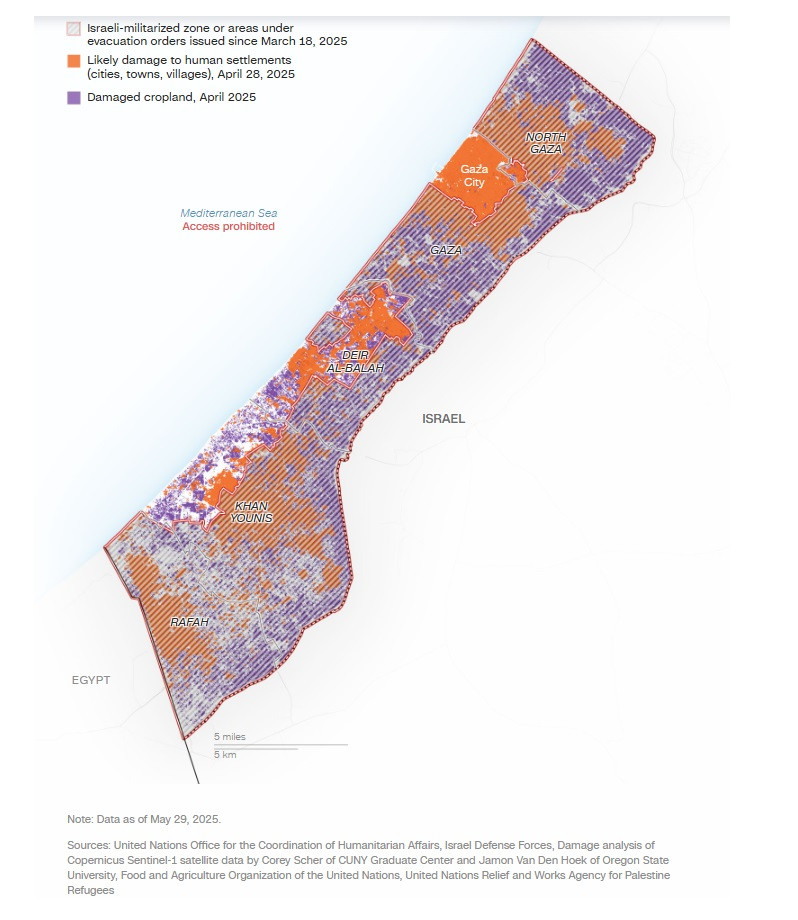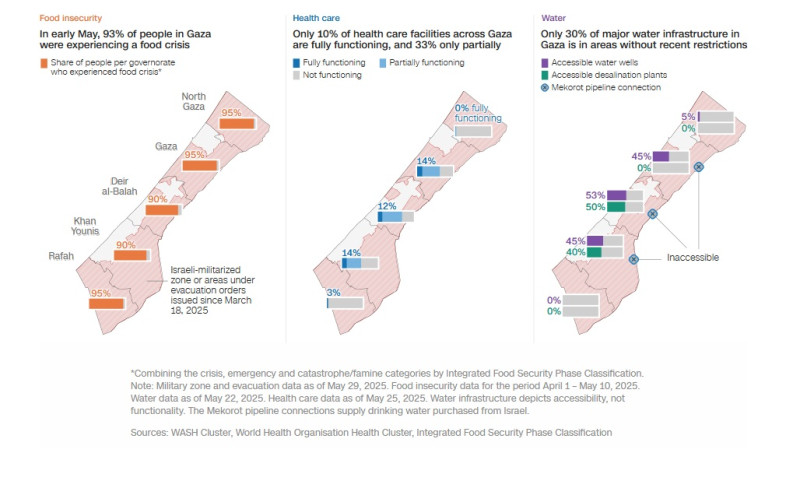Even before the Israeli war began in the Gaza Strip, the Palestinian pocket was one of the most densely populated places on the planet, with UN officials describing it as “outdoor prison”. In recent days, Israeli forces have expanded their operations, squeezing the population of Gaza into an ever -shrinking piece of land, as CNN notes in its analysis.
The latest military operation launched by Israel, named ‘Tanks of Gideon“, It aims at the total” occupation “of the area, as he was raised by Israeli government minister. Almost 80% of the pocket is either under evacuation orders or has been described as a militarized zone since March 18, when Israel violated the truce with Hamas, according to the UN.
Since then, Israel has been promoting its declared policy – with US support – encouraging the relocation of residents of Gaza.
In the context of the “Intensive Enterprise”, Israeli Prime Minister Benjamin Netanyahu said the entire population of Gaza – about 2 million people – will be displaced south of the 360 square kilometers.
The Israeli army claims that the operation aims to eliminate Hamas and release hostages.
But Israeli’s far -right finance minister, Bezalel Smotric, said the operation could lead to a complete occupation of the area, rather than more sincerely Tel Aviv’s ultimate goal.
“We will finally understand the Gaza Strip“, Said shortly after the approval of the expanded military operation by the Israeli Council of Ministers.
Is increasingly tightened by Israel
Some residents of Gaza in the north of the pocket report that they have fled to the nearby coastline in a last -ditch attempt to escape the new Israeli operation, exhausted by Israel’s 19 months. Others sleep in tents on the ruins of their homes, fearing to leave and forced to leave Gaza.
Ever since Israel violated the truce in mid-March, at least 2-3 kilometers on the Gaza land border has been converted into a banned zone, which includes a 1km seat belt next to Israeli territory, where houses, factories and agricultural land has been leveled.
Access to the Mediterranean Sea for fishing is almost forbidden. According to the UN Food and Agriculture Organization (FAO), most fishing boats have been destroyed and the Palestinians fishing near the coast are a target.
In early April another militarized corridor was created – Israel -bound “Morag corridor” in Rafa – which aimed to “divide the lane”. It is one of at least four corridors created to control Gaza by the Israeli army, which demolishes and clearances all buildings and arable land for this purpose.
Meanwhile, Israeli forces have issued at least 31 March 18th Commandments This year, which relate to large areas of the lane, sometimes issuing even two evacuation commands a day. As a result, About 600,000 people in Gaza have been displaced At this time (the number includes people who may have been displaced many times), according to the United Nations Management Cluster.
The evacuation orders are not necessarily permanent, but Israel has not specified how long it will be active. CNN has asked the Israeli army about whether these orders have an expiration date and how residents are informed in Gaza, but, as he points out, has not received an answer.
In northern Gaza, these commands were recently accompanied by instructions to move the displaced to the south, despite the fact that the attacks there continue. This week, the Israeli army issued evacuation orders for most of the southern Gaza, giving the Palestinians to head to the Al-Mawasi area, shortly before Israeli defense spokesman referred to the forthcoming “unprecedented attack”.
Groups that provide assistance to Gaza residents have criticized Israel for evacuation commandsnoting that they are confusing, often inaccurate and overly dependent on the internet in which most people in the pocket have access to intervals. They also point out that some receive text messages or phone calls before an attack, while others receive the “signal” with the first incoming Israeli fire.
Since Israel began its war in Gaza, after Hamas’ deadly attack in October 2023, Gaza residents have been displaced on average six times – some up to 19 times – according to the Danish Refugee Council.
Most of the other areas for which no evacuation orders have been issued or have not been militarized have suffered serious damage. According to Cuny’s Postgraduate Center 60% of buildings have been destroyedwhile UNHC and Palestinian Refugees Relief and Works Service (UNRWA) stated that 92% of houses have either been damaged or damaged. According to the UN satellite center, 68% of roads have also been damagedwhich further complicates the transfer of help to the lane.
In terms of arable land, a report published in the Journal of Science of Remote Sensing found that about 80% of tree crops – such as olives and fruit trees – are likely to have been damaged; as well as 65% of greenhouses used for food cultivation (tomatoes, cucumbers, peppers and strawberries).
FAO has also stated that all arable land in Rafa and almost all arable land in the northern provinces are no longer accessible.
And Al-Maussi, where the Israeli army sends thousands of people, is a narrow coastal strip in southern Gaza. The old ever agricultural land, since February is the most densely populated area in Gaza with About 116,000 peoplealmost 6% of the pocket population, have been displaced there, according to the UN Humanitarian Coordination Office.
Proper accommodation is now extremely rare in gauze. Omar Alsakka, a resident of Gaza working for doctors without borders at Han Younes, said in a statement to CNN that there were no scenes left, nor is there no room for people to set up scenes.
Further south, humanitarian workers say they are overly overworked, exhausted and are afraid that they will not be able to provide sufficient care if the flows of displaced are increased.
Medical facilities already face critical deficiencies In “almost all the necessary materials, from basic consumables to prevention and infections, to life -saving medicines,” Summer Al Jamal, who works at Nasser Hospital on the outskirts of Han Yunis for Palestine for Palestine, told CNN last week.
“If military operations continue, existing health facilities will simply not be able to cope with the number of displaced ones,” he said.
They also face a “overwhelming number of incidents that require urgent, specialized medical care. Care we can no longer provide, “Al -Jamal added, recalling how the case of a 10 -year -old boy who recently suffered a head injury to an air raid that killed his family could not be treated, as the medicines he needed were no longer available.
In addition to medical assistance, experts say Israel’s displacement plans will require the significant restructuring of the Gaza water supply system, much of which has already been damaged or damaged since the start of the war.
“Forcing the population to move … will be further wandering access to waterbecause new water supply points, new routes, new transport should be created, “Wim Zwijnenburg, who analyzes the environmental impacts of clashes for the Dutch Peace Organization, told CNN.
In southern Gaza, the 140,000 liters of fuel needed weekly to maintain water supply systems were not received last week, with local officials warning of forthcoming complete interruption, the UN said on May 21.
“The situation is particularly terrible in Al-Mauasi, which is not connected to the water supply network,” the UN said, adding that the area depends entirely on truck water supply.
There are hundreds of trucks with water, hygiene and drainage stuck outside the lane, ready to cross the border “at any time as soon as they are allowed,” the UNICEF told CNN on Thursday.
Source :Skai
With a wealth of experience honed over 4+ years in journalism, I bring a seasoned voice to the world of news. Currently, I work as a freelance writer and editor, always seeking new opportunities to tell compelling stories in the field of world news.












